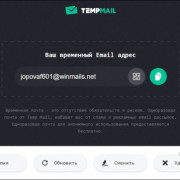Diskdigger: программное обеспечение для восстановления данных, которые вы потеряли на вашем компьютере
Содержание:
- Установка и использование DiskDigger
- News for March 2019
- Digging deep
- News for August 2020
- News for January 2021
- News for June 2021
- Типы файлов, поддерживаемые DiskDigger
- News for February 2014
- Saving by FTP uploading
- DiskDigger for Android updates!
- News for July 2016
- Вопросы и ответы о DiskDigger
- Ключевые особенности
- Huge updates for Android!
- News for April 2020
- How it works
- Digging deep
- Digging deeper
- Cleaning up
- News for July 2019
Установка и использование DiskDigger
Скачать утилиту можно в интернете, но предупредим сразу, — необходим также лицензионный ключ DiskDigger, чтобы пользоваться полным функционалом этого сервиса. Да, вы не получите приложение бесплатно, купив DiskDigger с ключом, но его возможности однозначно стоят своих денег.

Итак, для восстановления файлов необходимо выполнить следующие действия:
- После запуска и активации лицензионного ключа приложение выполнит поиск всех носителей, на которых можно запускать процесс восстановления.
- Выберите из списка требуемый накопитель — карту памяти, и нажмите на клавишу сканирования (Scan Device).
- Может появиться окно запроса прав суперпользователя (уже упомянутый root доступ) — подтвердите их.
- Далее произойдёт сканирование, после чего отобразится список файлов, которые доступны к восстановлению.
- Вы можете просмотреть каждый документ перед тем, как его восстанавливать, а чтобы вернуть их на карту памяти, просто отметьте галочкой и нажмите Save.
- Ещё доступно выделение сразу большой группы файлов — если так удобнее.
- Когда вы найдёте необходимые данные, нажмите Done.
- Если вы хотите сократить процесс сканирования и точно знаете, какие именно файлы вам нужны, можно задать поиск по параметру формата и размеру документов. По умолчанию DiskDigger photo recovery ищет файлы размером от 100 Кб.
Обратите внимание, что вернуть утерянную информацию можно не только на накопитель, но и отправив файлы по почте. Для этого после выбора файлов вам следует выполнить следующие действия:
- Нажмите Email, а не Save.
- В появившемся меню выберите службу, которой вы пользуетесь для отправки почты.
- Приложение создаст пустое письмо, в которое будут вложены выбранные документы в виде архива с названием DiskDiggerFound.zip.
- Таким же образом при выборе сервиса почты в списке появится облачное хранилище — если вы им пользуетесь, можете сразу отослать восстановленные файлы туда.
В меню присутствует также клавиша FTP Upload — ею можно пользоваться для сохранения информации на сервере данных. Для этого вам следует указать название сервера и авторизоваться в своей учётной записи.
Как видите, DiskDigger поможет вернуть потерянные данные и при этом имеет удобный интерфейс и поддержку нескольких способов сохранения файлов.
Именно так и происходит работа с сервисом DiskDigger. Приложение имеет хорошую репутацию среди пользователей, и если вы потеряли важные данные, не отчаивайтесь и обязательно попробуйте их восстановить таким способом. Весьма вероятно, что сервис станет ключом для решения вашей проблемы.
News for March 2019
Sat, 03/09/2019 — 15:02 — Dmitry Brant
I’m happy to announce some exciting new features in DiskDigger for Windows, as well as in DiskDigger for Android!
Let’s go over the Windows version first:

- «Dig Deep» mode has been enhanced with an option to show either «Deleted files only» (which was the previous default behavior) or «Deleted and existing files.» This is useful when the disk is improperly formatted or partitioned (or if the partition area is damaged), but the file system itself is still healthy. When you insert the disk and Windows shows an error such as «You need to format the disk before you can use it,» it’s an indication of this kind of issue. DiskDigger will now let you recover all the files from such a disk, whether or not they were actually deleted within the file system.
- In «Dig Deep» mode, there is now improved support for scanning certain file systems that are not native to Windows, including HFS+ (used in macOS disks) and ext4 (used in Linux).
- Enhanced support for scanning optical disks (CDs and DVDs) and the file systems that they contain, including ISO 9660 and UDF. There is also improved support for scanning damaged or improperly-burned disks: When selecting the drive to scan, you can go to the Advanced tab and check the «Detect disk size manually» box, which will make DiskDigger ignore the size of the disk as reported by the driver, and instead read the disk explicitly until it can no longer be read.
And here is what’s new in the Android version of DiskDigger:
- Support for recovering Opus audio files (when scanning rooted devices). The Opus format is used by WhatsApp for saving audio messages, which means that you can now recover WhatsApp voice notes. This format is also often used for ringtones and by other media recording apps.
- At last, you can now preview recoverable video and audio files, in place, without having to recover them first! (Previously only photos could be previewed.) Tap the «play» icon next to each recoverable file to show the preview dialog, then use the playback controls to play, pause, rewind, etc. (Note that this feature is only available on Android Marshmallow (6.0) and above.)
So what are you waiting for? Download DiskDigger for Windows for all your recovery needs on your PC, or find the DiskDigger app on the Google Play Store to recover files from your Android device.
Digging deep
The «dig deep» mode makes DiskDigger «undelete» files from the file system on your disk. Under most file systems, when you delete a file, it doesn’t actually get wiped clean from the disk. Instead, the file system will simply mark the file as deleted, and no longer show you the file when you browse the contents of the disk. DiskDigger scans the file system for such deleted files, exposes them to you, and allows you to bring them back as ordinary files again.
However, this kind of process has several limitations. Firstly, DiskDigger has to be «aware» of what file system is present on the disk. Therefore, it only supports certain types of file systems:
- FAT — Used on floppy disks (FAT12), most USB flash drives and memory cards under 4 gigabytes, and older hard disks (FAT16).
- FAT32 — Used on slightly older hard disks and most USB flash drives and memory cards with 4 gigabytes or greater.
- NTFS — Used on most modern hard disks.
- exFAT — Used on some modern hard disks and high-capacity memory cards and USB drives.
Fortunately, the above list of file systems covers the vast majority of the world’s users, so this limitation is trivial compared to the next one.
After a file is deleted, the file system is completely free to overwrite the contents of the deleted file with new data. From the point of view of the file system, the deleted file is now as good as free space, ready for the taking. The next file that is saved by the file system may just be written on top of the deleted one. If that happens, the deleted file will truly be lost forever.
So, a general rule would be something like this: The undelete process is effective only for files that have been deleted very recently. Or, more precisely: The probability of successfully recovering a file is inversely proportional to the amount of time elapsed after deleting it.
News for August 2020
Sun, 08/09/2020 — 22:37 — Dmitry Brant
 Just a quick but important update to DiskDigger for Windows:
Just a quick but important update to DiskDigger for Windows:
- Improved ability to recover compressed files in NTFS volumes. Compressed recoverable files will be automatically uncompressed when recovered.
- Added support for detecting PostScript (.PS) and Encapsulated PostScript (.EPS) files in Dig Deeper mode.
- Improved detection of old IBM PC-DOS partitions.
- The list of scannable disks now lists the drive letter(s) currently mapped to that disk.
- Improved saving and restoring of sessions, for pausing and resuming long-running scans.
Download DiskDigger now, and recover your data quickly, safely, and effectively.
News for January 2021
Mon, 01/18/2021 — 00:29 — Dmitry Brant
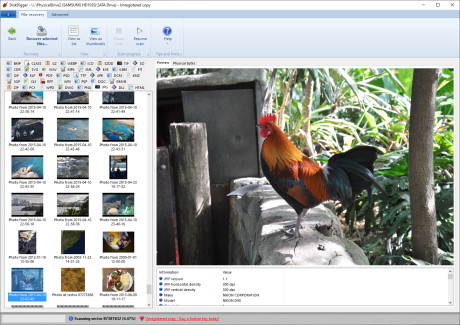 It’s time for another important update to DiskDigger for Windows! Here is what’s new in the latest version:
It’s time for another important update to DiskDigger for Windows! Here is what’s new in the latest version:
- Improved accuracy and efficiency of detecting certain raw camera formats, including Nikon (NEF) and Canon (.CR2).
- Revamped and improved recovery of .MP3 audio files. Will now recover a wider range of .MP3 files from different sources and devices.
- Added support for recovering .AAC audio files.
- Added an advanced option to perform a more thorough search for .MP3 or .AAC audio. After selecting «Dig deeper» mode (when selecting the types of files to search for), go to the Advanced tab and select the «Extra deep MP3 search» option. This option is still experimental and is not selected by default, since it can produce false positives.
- Added another advanced option to start the scan from a specific sector on the disk. When selecting the types of files to scan, go to the Advanced tab and enter the custom sector number in the «Starting sector to search from» text box.
Download DiskDigger for Windows now to search any of your hard drives, USB drives, or memory cards for deleted files!
And if you need to recover files from your Android device, try the DiskDigger app from the Google Play Store! Stay tuned for updates to the app, which will make recovering data even simpler and more effective.
News for June 2021
Sun, 06/27/2021 — 23:41 — Dmitry Brant
Time for another great update to DiskDigger for Windows, as well as DiskDigger for Android!Here is what’s new in the Windows version:
- Added support for recovering the latest version of Canon Raw images (.CR3).
- Improved support for recovering Adobe Digital Negative (.DNG) images.
- Added support for recovering iCalendar (.ICS) files.
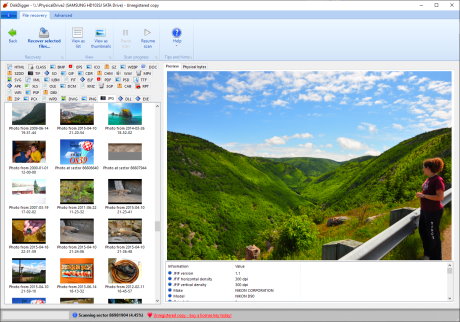
And here are the updates for the Android version:
Added a new option to filter results based on their location on the device, whether the location is a folder or a large file (such as a thumbnail cache or database) in which the results were found. After the Basic Photo Scan is complete, the «Filter» icon should appear in the toolbar at the top. If you tap this icon you should see a list of possible locations and the number of results found in each location. This should help in searching for a specific recoverable file by allowing you to select a location where the file is more likely to be.
Whether you need your photos, documents, or other data recovered from your Windows PC or your Android device, DiskDigger has you covered!
Типы файлов, поддерживаемые DiskDigger
DiskDigger поддерживает множество типов файлов, поэтому вы, скорее всего, сможете найти и восстановить этот файл или те файлы, которые вам нужно восстановить.
Фотографии и изображения
- JPG / JPEG — изображения с цифровых или веб-камер
- PNG — Портативные сетевые графические изображения
- GIF — графический формат обмена изображениями
- BMP — растровые изображения
- TIFF — изображения с тегами формат файла изображения
- ICO — иконки Windows
- АНИ — анимированные курсоры Windows
- CR2 — Canon RAW
- SR2 — Sony RAW
- NEF — RAW от Nikon
- DCR — Kodak RAW
- PEF — Pentax RAW
- RAF — Fujifilm RAW
- RW2 — Panasonic RAW
- LFP — Lytro RAW
- MPO — 3D изображения с камеры
- DNG — Adobe Digital Негативные изображения
- SVG — масштабируемые файлы векторной графики
- HEIC / HEIF — файлы
- PSD — изображение Adobe Photoshop
- РАН — Солнечные растровые изображения
- PSP — Corel Paint Shop Pro изображения
- Thumbcache — образы кэша Windows
- IFF — Amiga изображения
- ART — AOL изображения
- WMF — метафайлы Windows
- EMF — расширенные файлы MetaFile
- WMZ / EMZ — сжатые файлы MetaFile
- DICOM — медицинские документы
- WEBP — изображения WebP
- PCX — изображения ZSoft PCX
- CDR — файлы CorelDraw
- INDD — файлы Adobe InDesign
- CP — Adobe Captivate файлы
- AI — файлы Adobe Illustrator
Документы и файлы
- DOC — файлы Microsoft Word до 2003 года
- DOCX — файлы Microsoft Word 2007 или более поздней версии
- XLS — привет расчет Microsoft Excel до 2003 года
- XLSX — электронная таблица Microsoft Excel 2007 или более поздняя версия
- PPT — презентации Microsoft PowerPoint до 2003 года
- PPTX — Microsoft PowerPoint Presentations 2007 или более поздняя версия
- VSD — документы Microsoft Visio
- PDF — файлы формата Portable Document Format
- XML — файлы расширяемого языка разметки
- HTML — файлы языка разметки гипертекста
- RTF — файлы форматированного текста
- WPD — документы WordPerfect
- WPS — документы Microsoft Works
- PUB — документы Microsoft Publisher
- XPS — XML Paper Specification документы
- WRI — Старые окна для записи документов
- ODT, ODS, ODP, ODG — файлы формата OpenDocument
- DPP — Serif DrawPlus документы
- PPP — Serif PagePlus документы
Аудио и видео
- MP3 — очень распространенный аудиофайл MPEG layer 3
- WMA — Windows Media Audio
- AVI — аудио-видео чередование
- WAV — Волновое аудио
- MID-музыкальный инструмент цифровой интерфейс
- FLV — Adobe Flash Video
- WMV — Windows Media Video
- MOV — QuickTime видео
- M4A — MPEG-4 аудио
- M4V, MP4 — MPEG-4 видео
- 3GP — видео партнерства третьего поколения
- F4V — Adobe Flash видео на основе MPEG-4 часть 12
- RM — RealMedia видео
- RMVB — видео RealMedia (с переменным битрейтом)
- MKV — Матроска видео
- MPEG — группа экспертов по кинематографии
- AU — Sun Microsystems audio
- МТС, М2ТС — транспортный поток MPEG2
- R3D — красная видеокамера
- APE — Обезьяна Аудио Аудио
- OFR — OptimFROG аудио без потерь
- PPM, PGM, PBM — изображения Netpbm
- WEBM — видео WebM
Сжатые файлы
- ZIP — широко используемый формат сжатых файлов, разработанный PKWARE
- RAR — Архив Рошала, используемый WinRAR
- 7Z — сжатый 7-Zip файл
- GZ — сжатый формат GZIP
- SIT — StuffIt сжатый формат для Mac
- ACE — файл WinAce
- CAB — файл Microsoft Cabinet
- SZDD — сжатые файлы, созданные MS-DOS COMPRESS.EXE
Другие типы файлов
- ISO — образы оптических носителей, такие как CD и DVD
- EXE — исполняемый файл Windows
- DLL — динамическая библиотека Windows
- MDB — база данных Microsoft Access до 2003 года
- ACCDB — база данных Microsoft Access 2007 или более поздняя версия
- PST — личные папки Microsoft Outlook
- DBX — файл данных Microsoft Outlook Express
- XAC — файл данных GnuCash
- KMY — файл данных KMyMoney
- DWG — чертеж AutoCAD
- DXF — формат обмена чертежами
- CHM — скомпилированный файл Microsoft HTML Help
- TTF, TTC — шрифт TrueType
- CLASS — файл классов Java
- KMZ — геолокационные данные из Google Earth
- FIT — файл активности Garmin
- WALLET — Оружейная биткойн кошелек
- WALLET.DAT — кошелек с биткойн-ядром
News for February 2014
Sat, 02/15/2014 — 19:02 — Dmitry Brant
 Here are all of the latest updates included in the most recent release of DiskDigger:
Here are all of the latest updates included in the most recent release of DiskDigger:
- Improved detection and recovery of .MP4 video and audio files (includes .MP4, .M4V, .M4A, .MOV, .3GP, and other similar formats)
- Added support for recovering Opera Binary Markup Language (.OBML16) files.
- Added support for recovering Digital Embroidery files (.DST) and Tajima Embroidery files (.PXF).
- Added Ctrl-A keyboard shortcut to select all files when recovering.
- Improved file previews in Deep mode.
- Reorganized some internal code structure for better efficiency.
Download the latest version of DiskDigger now!
Saving by FTP uploading
The last method allows you to upload the recoverable files to an FTP server. In order to do this, you need to have access to an FTP server that is online, with the correct credentials for accessing and uploading to the server. DiskDigger will display a dialog for you to enter the FTP server’s host name, and your user name and password for logging on to the server:
You can also enter an optional subdirectory on the server where the files will be uploaded.
Tap «OK» to begin the uploading process. If the login to the server is successful, you will see status updates at the bottom of the screen, until all files have been uploaded. The files will be named based on the location where they were found.
DiskDigger for Android updates!
Sun, 02/15/2015 — 16:20 — Dmitry Brant
I’m thrilled to announce the latest update to the Android versions of DiskDigger and DiskDigger Pro (for rooted devices only)! This update features a redesigned and improved user interface, improved performance, and more powerful filtering options:
- The user interface has been cleaned up and simplified to feature search results more prominently, while placing recovery options and settings into the Action Bar on top.
- You may select between a List or Grid view for viewing recoverable files, as well as small, medium, or large thumbnails, for optimal browsing of search results (tap the Settings icon in the Action Bar).
- Each search result now has an options menu for recovering the individual result, as well as a checkbox for selecting multiple recoverable files for recovery.
- Tapping on a search result will bring up a Preview window with an enlarged thumbnail and additional information about the recoverable file.
- You may now filter the search results by date, although this only applies to .JPG and .TIFF files (tap the Settings icon in the Action Bar).
DiskDigger for Android is available for free from the Google Play Store, and can recover photos (.JPG), images (.PNG), and videos (.MP4, .3GP). If you need to recover other types of files from your Android device, please try DiskDigger Pro!
News for July 2016
Sun, 07/03/2016 — 22:44 — Dmitry Brant
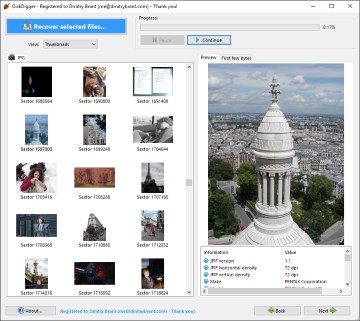 The latest version of DiskDigger for Windows is easier to use and more powerful than ever! Along with an improved interface with better instructions and visual cues, DiskDigger comes with these great new features:
The latest version of DiskDigger for Windows is easier to use and more powerful than ever! Along with an improved interface with better instructions and visual cues, DiskDigger comes with these great new features:
- In «dig deep» mode, there is now a new option to show files that were likely emptied from the Recycle Bin. If you’ve accidentally emptied the Recycle Bin, this will make it easier to find the files that were in it.
- In «dig deep» mode, recoverable files are now sorted by last-accessed time, so that files that were deleted more recently are likely to be near the top of the list. (You may still sort the files by name, size, or date by clicking on the corresponding column headers.)
- General performance improvements when filtering recoverable files in «dig deep» mode.
- Added support for recovering Lytro raw images (.LFP).
- Improved detection of 3D .MPO images.
- DiskDigger now requires version 4.0 of the .NET Framework. This means that it will run on Windows 10, Windows 8.1, and Windows 8 without needing any additional components. For running on Windows 7, Windows Vista, or Windows XP, you may need to install .NET 4.0 if it’s not already installed on your system.
- Experimental support for running on Mac OS X!
Download DiskDigger for Windows now!
Вопросы и ответы о DiskDigger
Я загрузил diskdigger, чтобы восстановить удаленные фотографии внутренней памяти, но фотографии в оригинале не восстановились. У меня есть Samsung Galaxy Note 4, и Diskdigger просит меня рутировать мой телефон.
Ответ. Вы не установили root, поэтому программа обнаружила только эскизы фотографий, к которым был доступ. Для полноценного восстановления предоставьте Diskdigger’у права суперпользователя.
Я хочу восстановить удаленные фото на телефоне meizu m3s. Рут доступ сделать не получается, так как я забыл пароль от аккаунта Flyme. Сторонние программы для рут прав не поддерживают модель моего телефона. С помощью DiskDigger мне удалось восстановить удаленные фото, но в плохом качестве.
Вопрос: как восстановить удаленные фото в исходном качестве без рут прав? Они были удалены именно с памяти телефона.
У меня телефон Xaiomi Redmi Not 5, я на нем удалила фотографии, точней, саму папку с фотографиями с внутренней памяти телефона и при этом у меня не было никаких синхронизаций с облаками. Даже удаляя фотографии, не папку, я их находила… Какими только приложениями не пыталась их найти, но все четно. Самым распространенным «DiskDigger». Помогите, пожалуйста. Может как-то через ПК можно. Я уже мало на что надеюсь, так жалко…
Я нашла свои удаленные фотографии через DiskDigger, но проблема в том что качество фото очень плохое, как восстановить фотографии с изначальным качеством ?
Хотела на телефоне перенести файлы в другую папку, через компьютер вырезала файлы, перешла в нужную папку, нажала вставить, но файлы не появились и в начальной папке их тоже нет. Телефон находится на гарантии,поэтому рутирование-не выход.Программа Disk Digger восстановила файлы,но в очень плохом качестве. Что можете порекомендовать в этом случае? Фото очень важны…
Сегодня перекидывала папку со скриншотами с телефона (Samsung Note 4) на компьютер. Папку я вырезала по глупости и хотела вставить, но произошел какой-то сбой — компьютер перестал видеть телефон и файлы так и не переместились; однако, и в телефоне скриншоты пропали, пыталась их найти везде. Так как эти скрины очень важные, хотела бы их восстановить. Попробовала бесплатные утилиты — disk digger, photo recovery, но они находят все, кроме этих самых скриншотов. Скажите, пожалуйста, есть ли какой-то шанс их восстановить?
У меня на телефоне пропали фотографии когда я скидывал их по беспроводному подключению на компьютер. Было вот как: компьютер подключен к роутеру через Wi-Fi, я подключил телефон к компьютеру тоже через роутер, так как через провод компьютер телефон не видит. На компьютере открыл папку с фото в телефоне, выделил фотографии и ПЕРЕТАЩИЛ их в браузер с открытым яндекс диском! Хотел сразу без копирования на компьютер закинуть их на яндекс диск. В итоге в папке яндекс диска фото не появились а с телефона исчезли! Около 600 фотографий объемом в 2,5 Гб исчезли за минуту, процесса копирования или удаления не было, они просто пропали в папке телефона. После этого я сделал root права на телефоне и просканировал программой diskdigger, установленной на телефоне, но она фото не нашла. Скажите пожалуйста, фотографии теперь не найти?
Ключевые особенности
- для полноценного функционирования приложения требуется наличие Root-прав;
- позволяет восстановить текстовые, аудио и видео файлы;
- возможно восстановление APK и архивов;
- найденными файлами можно поделиться по почте или отправить в облако;
- имеет интуитивно понятный русифицированный интерфейс;
- совместим со старыми версиями операционной системы Android.
Разработчик: Defiant Technologies, LLC Обновлено: 06-10-2017 Версия ОС: Android 2.3 и выше Русский язык: Присутствует Лицензия: Бесплатная Скачать (размер файла: 1,4 Мб) 1.0-2019-11-10 Приложение разработано для восстановления фотографий на мобильных устройствах под управлением Android. Для восстановления других типов файлов необходимо приобрести премиум версию приложения. Скачать
DiskDigger – приложение для восстановления фотографий на мобильных устройствах под управлением Android. Бесплатно для скачивания и использования. Имеет простой и понятный интерфейс с богатым функционалом. Работает со старыми версиями Android.
Huge updates for Android!
Mon, 11/04/2013 — 21:20 — Dmitry Brant
I’m pleased to announce the release of DiskDigger Pro for Android! This new version of DiskDigger is capable of recovering (carving) over 20 different types of files from your Android device’s internal memory, or an external memory card. This includes support for .JPG photos, .MP3 and .WAV audio, .MP4 and .3GP video, raw camera formats, Microsoft Office files (.DOC, .XLS, .PPT), and more!
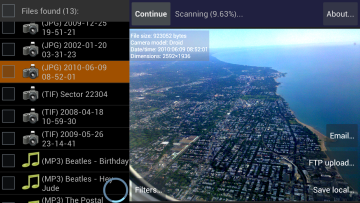
As with the non-Pro version of DiskDigger for Android, this app requires root privileges on the Android device. The non-Pro version of DiskDigger will remain available (for free!) on the Google Play store, and can still be used for recovering .JPG photos.
So what are you waiting for? Go to the Google Play store on your Android device, and install DiskDigger Pro today!
News for April 2020
Thu, 04/23/2020 — 14:00 — Dmitry Brant
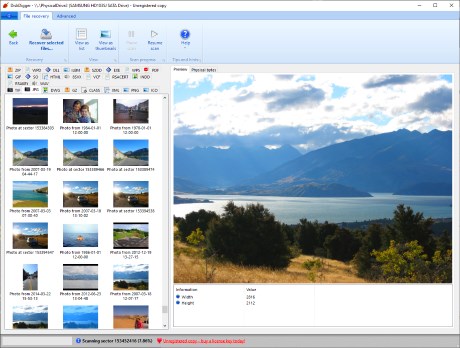
Time for another excellent update to DiskDigger for Windows, as well as DiskDigger for Android! Here is what’s new in the Windows version:
- Performance improvements when undeleting files from NTFS filesystems on certain drives.
- Performance improvements when recovering files from HFS+ (Apple) and ext4 (Linux) filesystems.
- Improved support for recovering damaged or corrupted DVD and CD-ROM media.
- Improved detection of VOB video tracks on certain DVD media.
- Added support for recovering and previewing ILBM (Amiga bitmap) images.
- Improved support and detection of USB floppy drives.
- Fixed an issue when reading fragmented files from FAT12 partitions.
Download DiskDigger now to recover your precious data from any kind of media that your PC can read.
And here is what’s new in the Android version:
- Improved compatibility with more Android 10 devices.
- Improved compatibility with older (KitKat and earlier) devices.
- Better performance of the Wipe Free Space feature.
Get the Android version of DiskDigger now from the Google Play Store to recover photos and other types of files from the internal memory of your phone or tablet.
How it works
DiskDigger has two modes of operation which you can select every time you scan a disk. These modes are called «dig deep» and «dig deeper.»
Digging deep
The «dig deep» mode makes DiskDigger «undelete» files from the file system on your disk. Under most file systems, when you delete a file, it doesn’t actually get wiped clean from the disk. Instead, the file system will simply mark the file as deleted, and no longer show you the file when you browse the contents of the disk. DiskDigger scans the file system for such deleted files, exposes them to you, and allows you to bring them back as ordinary files again.
However, this kind of process has several limitations. Firstly, DiskDigger has to be «aware» of what file system is present on the disk. Therefore, it only supports certain types of file systems:
- FAT — Used on floppy disks (FAT12), most USB flash drives and memory cards under 4 gigabytes, and older hard disks (FAT16).
- FAT32 — Used on slightly older hard disks and most USB flash drives and memory cards with 4 gigabytes or greater.
- NTFS — Used on most modern hard disks.
- exFAT — Used on some modern hard disks and high-capacity memory cards and USB drives.
Fortunately, the above list of file systems covers the vast majority of the world’s users, so this limitation is trivial compared to the next one.
After a file is deleted, the file system is completely free to overwrite the contents of the deleted file with new data. From the point of view of the file system, the deleted file is now as good as free space, ready for the taking. The next file that is saved by the file system may just be written on top of the deleted one. If that happens, the deleted file will truly be lost forever.
So, a general rule would be something like this: The undelete process is effective only for files that have been deleted very recently. Or, more precisely: The probability of successfully recovering a file is inversely proportional to the amount of time elapsed after deleting it.
Digging deeper
The «dig deeper» mode causes DiskDigger to become a powerful data carver, and carve out whatever files it can find on the disk, independent of the file system. Data carving refers to physically scanning every single sector on the disk, and looking for traces of known file types.
This mode also has some advantages and disadvantages. The main advantage is that it’s independent of the file system that’s on the disk, so the disk can be formatted as FAT, NTFS, HFS, ext2, or anything else; it doesn’t matter. DiskDigger scans «underneath» the file system, which gives it an additional advantage of being able to scan any free space on the disk outside of the file system, which the «dig deep» mode cannot do.
The main disadvantage of digging deeper is the time it takes to complete the scan. If you’re scanning a memory card or USB drive, it shouldn’t be too bad, but if you’re scanning an entire hard drive, be prepared for a several-hour job. Of course the burden of the time spent on the scan is subjective, and depends on the value of the files you’re trying to recover.
Another disadvantage of this mode is that only a limited number of file types can be recovered. Since we’re not aware of the file system, we have no way of knowing what types of files are present, so the only thing we have to go on are the actual bytes that we see on the disk. This means that DiskDigger has to be aware of the structure of the types of files we need to recover, and search for patterns of bytes specific to each file format. Fortunately, DiskDigger supports a fairly wide variety of file types which should cover most cases.
The only other disadvantage of this approach is that it’s not possible to recover files that have been fragmented by the file system. Since it’s not aware of the file system, DiskDigger has no way of knowing whether or not a certain file has been fragmented. So, technically, when digging deeper, DiskDigger will only recover the first fragment of a file. Most files consist of a single fragment anyway, but in some cases, the file system will choose to split a file into two or more fragments. A rule of thumb is: the larger a file is, the more likely it is that it’s been fragmented.
Cleaning up
Along with recovering your files, DiskDigger gives you the ability to delete them permanently, so that they will no longer be recoverable. Next to the «Recover» button you’ll find the «Clean up» button, which will take you to Clean Up mode:
The Cleanup screen is divided into two tabs: «Thumbnail caches» and «Photos.» This is because a thumbnail cache (a file that contains multiple thumbnails) must be deleted as a whole, which would delete all the thumbnails contained in it. Therefore the app allows you to examine these thumbnail caches, as well as individual photos, and select which ones you want to delete.
Cleanup Mode is currently available only in the Basic Scan. Making it available in the Full (rooted) scan is quite a bit more complex, and will be available in a future version.
Note: Since the deletion is done at the filesystem level, the contents of the deleted files are not physically wiped from the device’s memory, and may still be recoverable if the device is rooted. In fact, even physical wiping of the files’ contents is unreliable with flash memory, which employs wear-leveling that might redirect the overwritten data to a different physical location.
Wiping free space
Another powerful feature provided by DiskDigger is the ability to wipe the free space on your device’s memory. This is useful for ensuring that your deleted files (which are now considered free space in your device’s memory) will no longer be recoverable, even using tools like DiskDigger.
The «Wipe free space» feature can be accessed directly from the main screen of the DiskDigger app (underneath the selections of Basic Scan and Full Scan). It can also be accessed while performing a Full Scan by tapping the Cleanup button.
Like the «Clean up» feature, the «Wipe free space» feature is still a bit experimental, so you should be aware of some of its caveats and limitations:
- Wiping of free space is done by creating a temporary file and filling it with random data, until it consumes the entire amount of free space on your device. When the temporary file begins to reach the limit of free space, the Android system will usually display a notification that your available space is running out. You should ignore this notification until the wipe process is complete. When it finishes, it will delete the temporary file and free up the remaining space again.
- It is possible that the Android system will stop DiskDigger from being able to write to the temporary file before the memory is completely full. This means that there is a possibility that not all of the free space will be wiped, and some deleted data might still be recoverable. You can always re-run DiskDigger and scan your device’s memory to ensure whether the wipe was successful.
- The wiping is done only on the internal memory of the device. The ability to wipe an external SD card will be added in a future version.
- It’s important to note that because the wiping is done by overwriting all the free space, it means that the process inflicts a significant amount of wear on the device’s memory. This can potentially shorten the life span of the memory, and should be performed sparingly, and only when necessary.
News for July 2019
Tue, 07/16/2019 — 21:08 — Dmitry Brant
The latest update to DiskDigger for Windows improves upon its general performance, as well as these specific enhancements:
- Improved handling of compressed files in NTFS filesystems. When your disk is formatted with NTFS, individual files can be compressed (using a variation of LZ77) to conserve disk space. When scanning in «Dig Deep» mode, DiskDigger automatically and transparently decompresses these files, so that they can be recovered in their original state.
- Improved handling of system-compressed files in NTFS. Windows 10, as part of its background operation, searches for certain files that are seldom used and automatically compresses them. This is different from the «standard» compression that can be applied to NTFS files. This compression is done by creating an alternate data stream (with a reparse point) called «WofCompressedData» and filling it with the compressed data, which is compressed with the Xpress or LZX algorithms. DiskDigger handles all of these cases, and automatically recovers these types of files in uncompressed form.
- Added support for recovering Quicken data files (.QDF) in «Dig Deeper» mode.
- Improved efficiency of recovering executable (EXE and DLL) files.
- Fixed some possible stability issues when previewing WAV audio files.
In other news, DiskDigger for Android also received an update, with improvements to its «Wipe free space» function, which is now faster and more effective than before.

Download DiskDigger for Windows to recover deleted files from any media readable by your PC! And for recovering data from your Android device, find the DiskDigger app on the Google Play Store!


